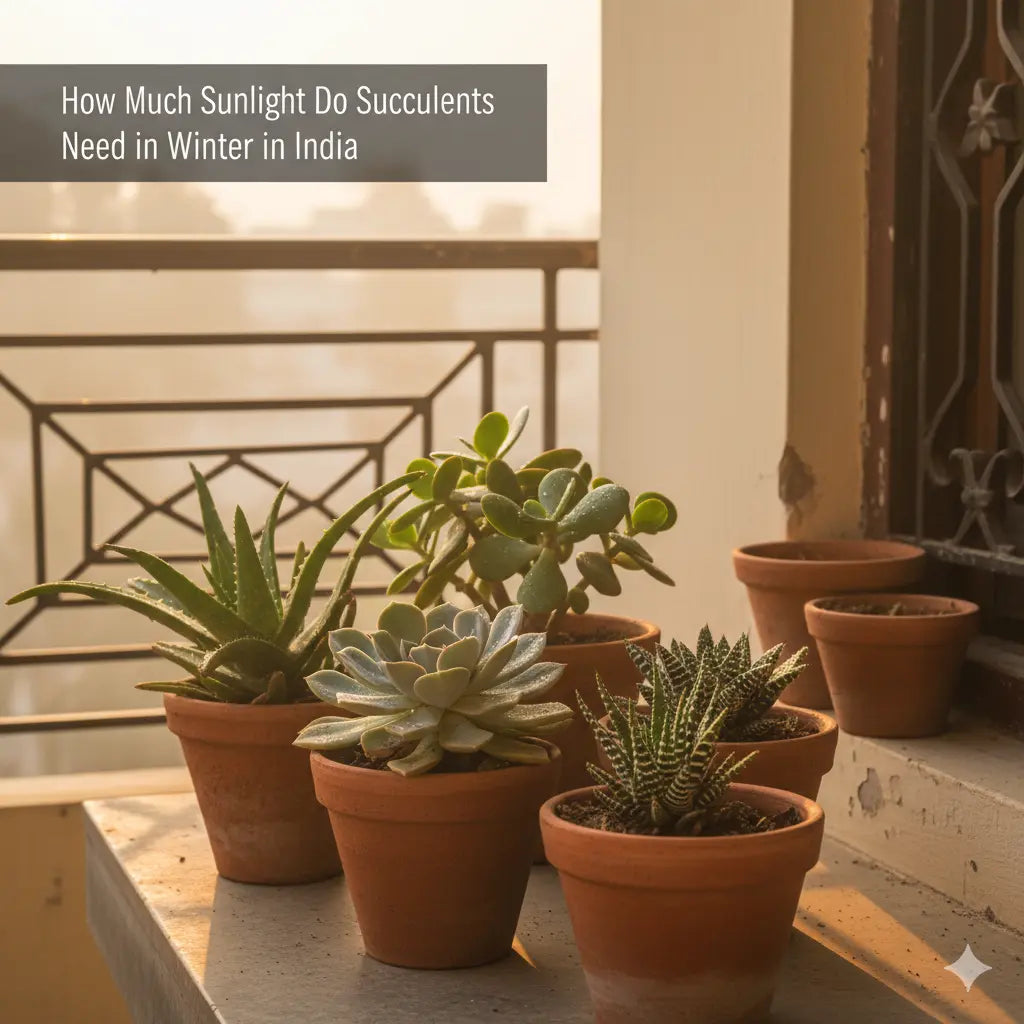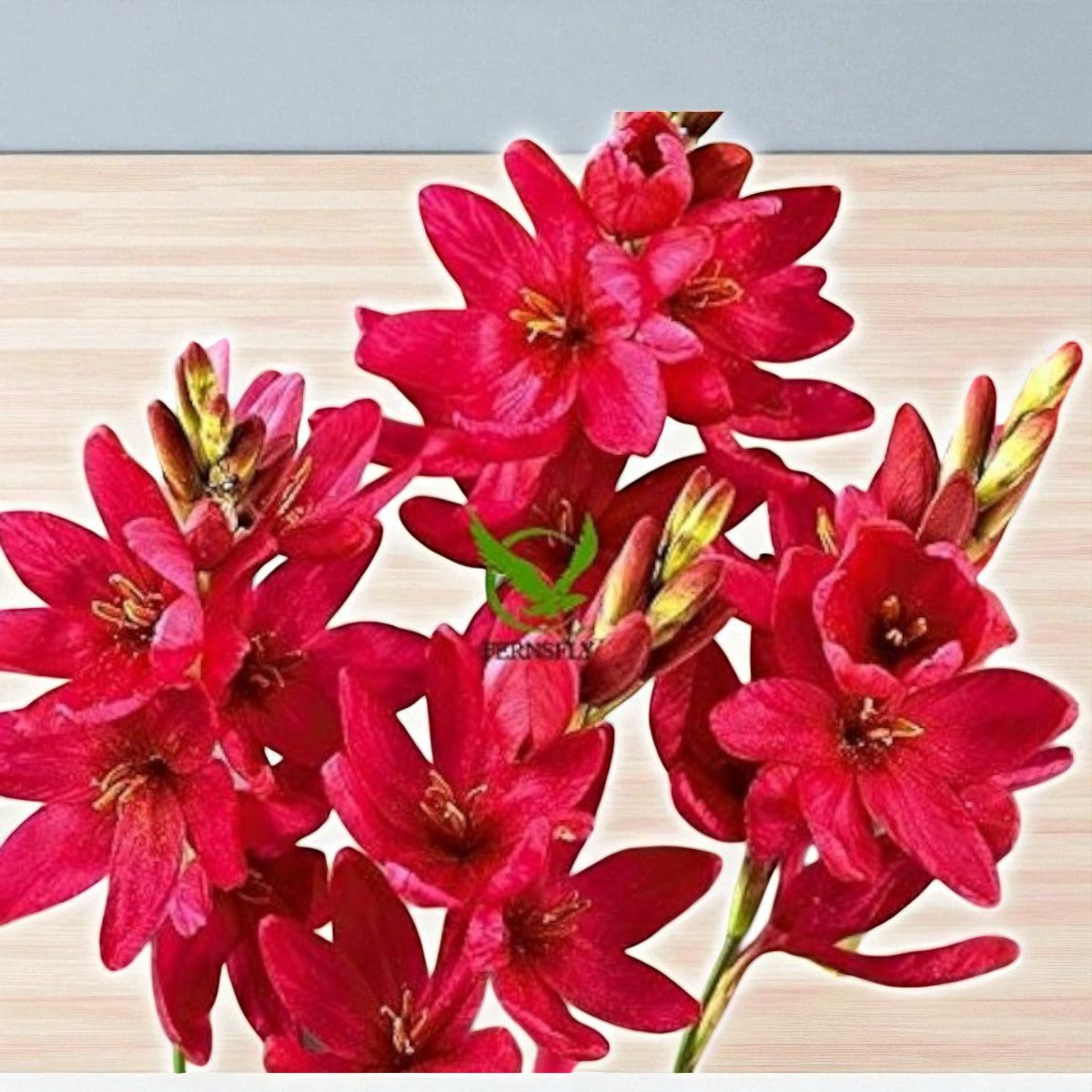
How Much Sunlight Do Succulent Plants Need in Winter in India
Introduction – Meet the Succulent Plants
Succulent plants are nature’s small water tanks. They store water in thick, fleshy leaves or stems to survive long dry days. You will find them in many Indian homes, on balconies, windows, and even in offices. They look cute, require little water, and are perfect for busy people who love greenery.
Succulent Plants come in many types — like aloe vera, jade plant, haworthias, echeveria, and sedums. What makes them special is their strength to live with very little care. But one thing every succulent plant needs to stay healthy is proper sunlight.
Without the right sunlight, even the healthiest succulent begins to look weak, pale, or stretched. That’s why learning about sunlight for succulents, especially in the Indian winter, is important for every plant lover.
Why Sunlight Matters for Succulent Plants
Sunlight is food for plants. It helps them make energy through photosynthesis — the process that keeps them alive and growing. For succulents, sunlight plays a bigger role because:
- It keeps their leaves firm, colorful, and full of life.
- It prevents stretching and weak growth.
- It helps them hold their pretty shapes.
In short, sunlight for succulents is like breakfast for humans — you can skip it for a day, but soon the body (or plant) feels weak.
If your succulent plant gets little light, you’ll notice slow growth, soft stems, and faded leaf color. Too much direct sun, however, can burn the leaves. So, getting balanced sunlight is the key to good succulent care in winter.
India’s Winter and Its Effect on Succulent Plants
India’s winter weather changes from north to south.
- In North India (like Delhi, Punjab, and Uttar Pradesh), mornings are foggy and sunlight feels mild.
- In South India (like Tamil Nadu and Kerala), winter is warmer and sunlight remains bright.
- In Western India (like Gujarat and Maharashtra), days are sunny but nights can be cool.
Because of this, succulent plants receive sunlight of different strengths depending on where they are grown. In colder northern areas, short days mean less sun. The fog and mist also reduce light hours. In southern areas, sunlight is still good but intense midday rays can sometimes dry out leaves if the plant sits too close to glass.
So, during winter in India, you must adjust your succulent’s placement according to your region to give it steady energy without harm.
How Much Sunlight Do Succulents Need in Indian Winter
During Indian winter months — from November to February — succulent plants need 4 to 6 hours of soft sunlight daily.
Morning sunlight (before 10 AM) is best. It is warm and gentle, just what succulents love.
Afternoon sunlight (2 to 4 PM) can be used for hardy types like aloe or agave, especially in foggy areas, but avoid keeping them under strong sun behind glass for too long.
Here’s a quick regional guide:
| Region | Ideal Sunlight Hours | Best Time for Sunlight |
|---|---|---|
| North India | 5–6 hours | 8 AM to 2 PM |
| South India | 3–4 hours | 8 AM to 11 AM |
| East India | 4–5 hours | 9 AM to 2 PM |
| West India | 4–6 hours | Morning light preferred |
If you can’t give full sunlight, bright indirect light also helps. Place plants near a balcony or window where gentle rays touch them daily.
Signs of Low Light in Succulent Plants
Your succulent will show clear signs when it’s not getting enough sunlight. Watch out for these changes:
- Leaves start leaning or stretching toward the light.
- The plant grows tall and thin, losing its compact shape.
- Leaf color fades from bright green or red to pale yellow.
- The lower leaves may drop or feel soft.
If you see these, move your succulent to a brighter place. Within days, you’ll notice the plant firming up and returning to its healthy color.
1. Find the Sunny Spot
Succulents are like those people who love a good, warm chai on a winter morning. If you keep them away from the sun, they get all dull and lazy. When your plant is near a window or balcony and the sun hits it in the morning, it soaks up all that goodness to stay strong and shiny. Without sunlight, it will start stretching itself—like reaching out for the last samosa—just to get a bit of light. That’s why best spot is always where morning sun comes in nicely.
2. Rotate the Pots
If you always sit at one spot during dinner, only that side of your face gets tan, right? Same with succulents. If you don’t rotate them, one side keeps getting all the light, other side gets ignored and weak. By rotating, you give every part of the plant a fair chance at sunlight—no partiality! This way, your plant looks good from all angles, not one fat side and one hungry side.
3. Water Less
In winter, even we drink less water and go slow with the cold. Plants feel the same! They aren’t growing fast, so if you keep pouring water thinking more is better, the soil stays wet and starts smelling. Then, the roots begin to rot—just like if you kept your chappals wet for days, they go bad. Succulents are smart, they store water and only want a sip, not a bucket.
4. Avoid Fog Exposure
Ask anyone who lives in north India—foggy winter is no joke. All that moisture in the air sits on leaves, and if it gets too much, your leaves can catch fungus or start getting soft patches—like when school shoes don’t dry fast. If you see heavy fog, better keep the plants inside or at least somewhere dry. Leaves need more light and less wetness in winter.
5. Clean Leaves Regularly
You know how your specs get dirty in winter and you can’t see clearly? Dust on plant leaves is the same! If too much dust or fog sits on them, they can’t soak sunlight properly, and all their hard work goes to waste. Wipe them with a soft cloth, like you’d clean your TV screen or favourite photo frame. Clean leaves = happy, healthy plant.
With these steps, you can maintain beautiful, strong succulents all through the cold months.
Indoor Succulents in India
Indoor succulent Plants in India are common because many homes don’t have open gardens. These plants can still thrive, but you must help them get proper light.
Tips for indoor succulents in winter:
- Keep plants near east or south-facing windows where sunlight stays longest.
- Avoid placing them in dark corners or under direct fans.
- Use a small grow light if your home is very shady. Even 3–4 hours under it helps.
- Don’t rush to water just because soil looks dry; always check if it feels dry deep inside.
Jade plant, zebra haworthia, and aloe vera are excellent indoor choices. They stay green and healthy even with moderate light when placed correctly.
Outdoor Succulent Care in Winter
Outdoor succulents love the soft Indian winter sunlight. But exposure to heavy dew or frost in some areas can cause trouble.
Here is How to Keep them safe:
Morning Sun Only
See, succulents are just like us. If you ask anyone in the colony, they’ll tell you that morning sun is the sweet spot for most plants—never too harsh, just gentle warmth to wake them up. Let them enjoy the morning light for some hours and by noon, shift them to shade or let the sun move away on its own. Trust me, they don’t need a full-day heat party.
Avoid Frost
When nights get chilly, especially in places with freezing temperatures, covering plants is a real “maalik ka kaam.” It’s just like your granny pulling out extra blankets in December—same thing for succulents, just use a thin cloth. If it’s really cold, plants prefer being inside with the rest of the family. No “thand lag gayi” drama for your succulents then!
Good Drainage
Simple rule: if you let water stay in the pot, it’s like leaving dishes unwashed after lunch. Smell comes, and things rot. Succulents hate soggy soil—they want fast drainage, like quick gossip running through the mohalla. Pots with holes and sandy soil will keep everything airy and dry, so roots stay healthy and happy, even after that one random heavy shower.
No Cold Water
Imagine washing your feet in cold water during Delhi’s winter—shocking, right? Same thing for your plant’s roots. Pouring cold water feels funny to them. Regular room temperature water is best, simple and comforting. No need to surprise them with chilly sips—save the “cold fights” for your siblings!
Group Plants Together
This is full desi-jugaad! Like everyone sitting together in a room when it’s cold outside, plants also feel cozy when placed side-by-side. It’s easier to care for them, cover them if needed, and they even help each other stay a bit warm. Plus, seeing all your succulents in one place feels good, no?
So, don’t go overboard—just keep things natural, practical, and use your own Indian commonsense. Your outdoor succulents will handle winter like true desi champs!
Outdoor succulents like echeveria, graptoveria, and sedum love bright Indian winter weather when protected properly.
Protecting from Cold Winds and Fog
Indian winters vary from mild to chilly. In the north, cold winds and fog can damage delicate leaves.
You can protect your succulents by:
- Moving them indoors during cold nights.
- Placing them beside a wall or window that blocks direct wind.
- Covering small pots with net fabric or a light transparent cover at night.
- Keeping them off the floor if you live in very cold areas — use stands or tables.
Avoid plastic coverings that trap water or fog, as that can cause fungus.
Balancing Light and Temperature
Succulent plants love sunlight but not extreme temperature change. Keep them at a steady, warm spot between 10°C and 25°C.
If the room feels too cold, place the pots a few feet away from windows at night. Never keep them near a heater or close to thick curtains blocking air.
Balanced light and stable temperature make the best environment for succulent care in winter.
Example: Aloe Vera and Jade Plant
Aloe Vera: Needs 5 hours of sunlight daily. Perfect for balcony corners or near bright windows. Water every 12–14 days in winter.
Jade Plant: Likes 4 hours of morning sunshine. Protect from fog and cold air at night.
Haworthia: A good indoor succulent that grows well with filtered sunlight.
These common examples show how adjusting placement and light helps every succulent stay strong.
Winter Plant Care Summary
Taking care of succulent plants in winter is simple when you follow three golden rules:
- Give 4–6 hours of sunlight daily, mostly morning light.
- Water less and check soil dryness first.
- Keep plants warm and protect them from cold winds or fog.
Succulent plants bring life to homes in every season. With sunlight, steady warmth, and little care, they shine bright even in chilly Indian winters. Good sunlight means healthy succulents — strong, colorful, and full of life.
Final Takeaway
Succulents are tough but need love too.
This winter, find them their cozy sunny spot, water wisely, and keep them safe from cold air.
Whether indoors or outdoors, your succulents will thank you with firm leaves, bold colors, and steady growth.

